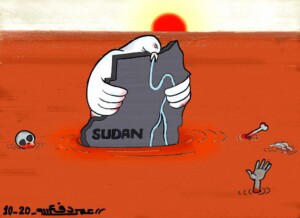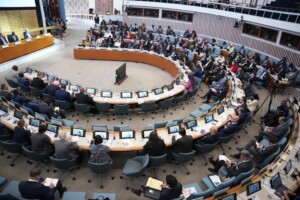Sudan OCHA bulletin 4: FAO Regional Conference for Africa in Khartoum
The UN Office for the Coordination of Humanitarian Affairs (OCHA) reported in its latest biweekly bulletin that African Ministers of Agriculture met in Khartoum in February to chart a new path for agricultural development and food security in Africa. According to the UN Food and Agriculture Organisation (FAO) the prices of the main staples in Sudan rose sharply in January. A new project by Mercy Corps Scotland (MC-Scotland) will meet water and sanitation needs of about 40,000 people in East Jebel Marra. UN agencies and the government’s Voluntary Return and Reintegration Commission (VRRC) sent an inter-agency mission to assess the situation of 1,500 returnees in South Darfur’s Dafag village.

The UN Office for the Coordination of Humanitarian Affairs (OCHA) reported in its latest biweekly bulletin that African Ministers of Agriculture met in Khartoum in February to chart a new path for agricultural development and food security in Africa. According to the UN Food and Agriculture Organisation (FAO) the prices of the main staples in Sudan rose sharply in January. A new project by Mercy Corps Scotland (MC-Scotland) will meet water and sanitation needs of about 40,000 people in East Jebel Marra. UN agencies and the government’s Voluntary Return and Reintegration Commission (VRRC) sent an inter-agency mission to assess the situation of 1,500 returnees in South Darfur’s Dafag village.
The 30th Regional Conference for Africa titled ‘Sustainable Development of Agriculture and Food Systems in Africa’ was held in Khartoum on 19-23 February, and discussed climate change and resilience building to address the vulnerability of Africa’s agriculture and rural livelihoods.
In an OpEd ahead of the Africa Regional Conference, FAO Director-General José Graziano da Silva said: “It is encouraging that some parts of the continent have made some significant progress, but significant challenges remain for all”.
In Sudan, for example, the prevalence of undernourishment in the total population of the country from 2014 to 2016 was 25.6 per cent, according to the 2017 State of Food Security and Nutrition in the World Report. This represents a 40 per cent reduction in levels of under-nourishment, as compared with 1990 levels, to 27.5 per cent (2000-2002) and even further to 25 per cent in 2005-2007, as analysed in the State of Food Insecurity in the World Report 2015.
2017 Africa Regional Overview of Food Security and Nutrition
The increase of hunger in Sub-Saharan Africa in 2016 is directly linked to conflict and the impacts of climate change, such as prolonged drought, which has affected rural areas of many countries, said the FAO Director-General.
Low levels of productivity, weak value chains and high levels of vulnerability to crises have also contributed to the deterioration of food and agriculture systems and rural livelihoods, especially in relation to the poorest people.
One reason for optimism is that the political will to redouble anti-hunger efforts is running higher than ever, said the FAO Director-General during the conference. This effort was manifested in the high prominence the issue received during the recent AU Summit attended by the continent's top leaders, as well as UN Secretary-General António Guterres.
Food prices continue to increase in Sudan
Prices of the main staples in Sudan, sorghum, millet and wheat, rose sharply for the third consecutive month in January, despite the recently completed main season harvest, FAO said in its latest Food Price Monitoring and Analysis (FPMA) Bulletin.
The increase in prices was driven by the removal of the wheat subsidies under the new budget of 2018, which increased demand for millet and sorghum as substitutes for wheat and by a strong depreciation of the local currency in the parallel market, according to the FPMA Food Policies.
Localised but substantial crop production shortfalls are affecting the current harvest, which contributes to further cereal price increases. According to the preliminary findings of the 2017 FAO Crop and Food Supply Assessment Mission (CFSAM), the 2017 aggregate cereal production is estimated at 5.2 million metric tons (MT), about 40 per cent lower than the record 2016 output. This is mainly due to production shortfalls in Kassala, Gedaref and North Darfur states, where harvests were 66-90 per cent lower than in 2016, following poor and erratic rainfall, according to FAO GIEWS Country Brief for Sudan.

Mercy Corps Scotland brings safe water and sanitation in East Jebel Marra
A new project by the international NGO Mercy Corps Scotland (MC-Scotland), with the support of state ministries and local authorities in South Darfur State, will meet the safe water and sanitation needs of about 40,000 people (displaced, returnees and members of the host community) in 13 villages in East Jebel Marra.
The project, funded from the 2017 Sudan Humanitarian Fund Reserve for Emergencies became feasible due to improved access to East Jebel Marra. MC-Scotland is working to ensure that beneficiaries in targeted locations and localities have access to more than 10 litres per person per day of safe drinking water.
The rehabilitated water systems will be operated by a hybrid solar power system, which generates energy from the sun. MC-Scotland will train and establish five community-based committees to manage the water systems.
The construction of 959 household latrines using the Community Led Total Sanitation approach will provide the community with adequate sanitation facilities.
Working with communities to inform response in South Darfur return village
Following the return of nearly 1,500 Sudanese refugees from the Central African Republic (CAR) to South Darfur’s Dafag village in El Radoom locality late last year, the UN Refugee Agency (UNHCR) and the Recovery, Return, and Reintegration (RRR) sector, led by the UN Development Programme (UNDP) and the government’s VRRC, organised an inter-agency assessment mission to the area.
The mission confirmed the need for enhancements to health, water, education, sanitation and hygiene services for both the returnee and host communities.
UNHCR and the Commissioner of Refugees (COR) have also worked with the locality commissioner to establish land and security committees, and have further ensured land allocation to returnees. In addition to the returnees from CAR, there are also 500 returnees from camps for the displaced in Nyala. According to the VRRC, a further 3,000 residents of the two camps also intend to return to Dafag, as the security situation has improved.
Limited access to water, health, sanitation, and education facilities are key concerns in Dafag for both returnees and host communities, particularly with the increasing population. Initial assistance from the UN Children’s Agency (Unicef) and Norwegian Church Aid with chlorination tablets and water management training, has helped improve water quality.
The mission as well recommended constructing a health clinic in the area. While sanitation facilities are largely lacking in Dafag, UNHCR constructed 20 communal latrines at a reception centre.
The UN Refugee Agency also provided cash assistance to the returnees to help them construct household latrines, as part of their shelters. Approximately 750 returnee children need access to schools and qualified teachers.











 and then
and then